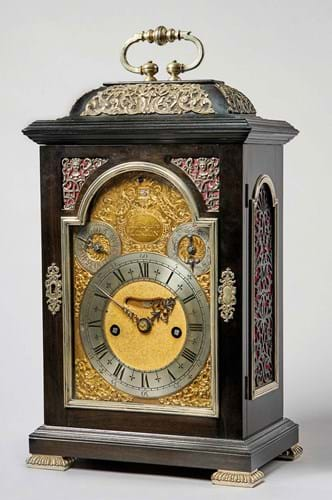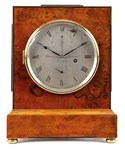The enigmatic group of clocks that combine ‘Thomas Tompion’ quarter-repeating movements and dials with the signature of Daniel Quare add an extra chapter to the story of English Golden Age clockmaking.
This blending of the talents of two ‘rival’ City of London workshops points to occasional moments of collaboration between near neighbours or the work of a close associate.
Economics may have played a role. A contemporary recorded that ‘Tompion based at the Sign of the Three Dials on water Street’ could get as much as £10 for his clocks, whereas other London clockmakers, such as Quare based at the King’s Arms in Exchange Alley, could only get £4 to £6. It has been suggested that James Tunn, one of the principal outworkers for Tompion, may have been the common supplier.
To date only half a dozen clocks of this type have been identified – including the spring table clock housed in a silver-mounted tortoiseshell case c.1695 shown by Anthony Woodburn at last year’s Masterpiece fair and an ebony cased clock c.1710 sold by Carter Marsh as part of the John Scott collection in 2015.
To date only half a dozen clocks of this type have been identified
Unrecorded example
A seventh, previously unpublished and unrecorded clock from the group emerged for sale at Bellmans’ (22% buyer’s premium) in Wisborough Green, West Sussex on May 14 as part of a 70-lot clock sale.
Although both the dial and the floral-engraved backplate are signed by Quare, they display all of the known quirks of the late Tompion output c.1710 or that of his successor George Graham.
It came for sale by descent from the family of Professor Hans Bertele von Grenadenberg (d.1984), clock collector and author of a standard work on chronometers.
Gauging its commercial worth was difficult: these clocks are typically priced below a signed Tompion and in this case the 18in (45cm) high silver mounted ebony case was a replica made in the second half of the 20th century. Ultimately the broad estimate of £20,000-40,000 proved correct with the clock sold to a private buyer at £25,000.
Catalogue details
Tompion expert Jeremy Evans provided the textbook cataloguing for both this clock and a George II walnut longcase that combined a movement by George Graham with an associated case.
Although bought by the vendor c.2000, it is thought to be one of three early longcase movements and dials that were sold for scrap in the post-war era.
One of the clocks (a month-going Tompion) had been owned by the collector-dealer Francis Herbert Green (1872-1936) prompting the theory that all were once in his bombed-out home close to the Royal Exchange.
The substantial five-pillar movement with bolt and shutter maintaining power, deadbeat escapement and a rack strike is numbered 709 for c.1733. The present walnut case, perfectly correct in style and period with its cushion-moulded hood flanked with gilt-brass-mounted columns, was found for it during the 1960s.
It sold to a private buyer at £17,000 (estimate £15,000-25,000).















